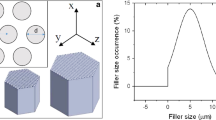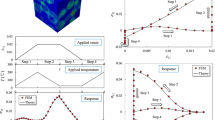Abstract
In this work, a method is proposed for modeling RTM process and the associated mechanical behavior of composites filled with mono-sized spherical Alumina particles. This method combines (i) a numerical model (RTM model) that allows the simulation of the RTM process during the injection of particle filled resins and (ii) a computational strategy of mechanical properties based on the homogenization methods. These proposed models have already been validated with experimental results. The RTM model is based on 3 sub-models: the first one to describe the suspension flow, the second one to simulate the advance of the flow front, and the last one to model the particles filtration by the fibrous medium. The distribution result of the concentration of particles in the fibrous medium obtained at the end of the simulation of the injection is used as input data for mechanical models of homogenization. The homogenization numerical model was constructed from a representative volume element of the microstructures using the Poisson process. The idea here is to couple these two steps (RTM simulation + mechanical property computation) in a complete model which allows at the same time and in a single operation: to simulate the process of the manufactured composites loaded with particles and to deduce their induced mechanical properties. The pertinence of the proposed method is confirmed by the simulation of nine elastic properties of composites with the finite element method. The influence of post-filling on the induced mechanical properties has been studied.


















Similar content being viewed by others
Data availability
The authors declare that the data and the materials of this study are available within the article.
Code availability
Not applicable.
References
Djebara Y, Imad A, Saouab A, Kanit T (2020) A numerical modelling for resin transfer molding (RTM) process and effective thermal conductivity prediction of a particle–filled composite carbon–epoxy. J Compos Mater 55:3–15
Chohra M, Advani SG, Yarlagadda S (2007) Filtration of particles through a single layer of dual scale porous media. Adv Compos Lett 16:205–221
Steggall-Murphy C, Simacek P, Advani SG, Yariagadda S, Walsh S (2010) A model for thermoplastic melt impregnation of fiber bundles during consolidation of powder- impregnated continuous fiber composites. Compos A: Appl Sci Manuf 41:93–100
Nordlund M, Fernberg SP, Lundström TS (2007) Particle deposition mechanisms during processing of advanced composite mate rials. Compos A: Appl Sci Manuf 38:2182–2193
Tarfaoui M, El Moumen A, Boehle M, Shah O, Lafdi K (2019) Self-heating and deicing epoxy/glass fiber based carbon nanotubes buckypaper composite. J Mater Sci 54:1351–1362
Shaker K, Nawab Y, Saouab A (2019) Influence of silica fillers on failure modes of glass/vinyl ester composites under different mechanical loadings. Eng Fract Mech 218:106605
Shaker K, Nawab Y, Saouab A (2020) Experimental and numerical investigation of reduction in shape distortion for angled composite parts. Int J Mater Form 13:897–906. https://doi.org/10.1007/s12289-019-01510-6
Xie F, Pollet E, Halley PJ, Avérous L (2013) Starch-based nano-biocomposites. Prog Polym Sci 38:1590–1628
Manfredi E, Michaud V (2014) Packing and permeability properties of E-glass fibre reinforcements functionalised with capsules for self-healing applications. Compos Part A Appl Sci Manuf 66:94–102
Louis BM, Maldonado J, Klunker F, Ermanni P (2019) Particle distribution from in-plane resin flow in a resin transfer molding process. Polym Eng Sci 59:22–34
Sandler JKW, Kirk JE, Kinloch IA, Shaffer MSP, Windle AH (2003) Ultra-low electrical percolation threshold in carbon-nanotube-epoxy composites. Polymer (Guildf) 44:5893–5899
Andrianov IV, Danishevs’Kyy VV, Kalamkarov AL (2010) Analysis of the effective conductivity of composite materials in the entire range of volume fractions of inclusions up to the percolation threshold. Compos Part B Eng 41:503–507
Lee GW, Park M, Kim J, Lee JI, Yoon HG (2006) Enhanced thermal conductivity of polymer composites filled with hybrid filler. Compos Part A Appl Sci Manuf 37:727–734
Qian L, Pang X, Zhou J, Yang J, Lin S, Hui D (2017) Theoretical model and finite element simulation on the effective thermal conductivity of particulate composite materials. Compos Part B Eng 116:291–297
Guan FL, Gui CX, Zhang HB, Jiang ZG, Jiang Y, Yu ZZ (2016) Enhanced thermal conductivity and satisfactory flame retardancy of epoxy/alumina composites by combination with graphene nanoplatelets and magnesium hydroxide. Compos Part B Eng 98:134–140
Fernberg SP, Sandlund EJ, Lundström T (2006) Mechanisms controlling particle distribution in infusion molded composites. J Reinf Plast Compos 25:59–70
Wang YH et al (2019) Activated carbon spheres@NiCo2(CO3)1.5(OH)3 hybrid material modified by ionic liquids and its effects on flame retardant and mechanical properties of PVC. Compos B Eng 179:107543
Kashiwagi T, Du F, Douglas JF, Winey KI, Harris RH, Shields JR (2005) Nanoparticle networks reduce the flammability of polymer nanocomposites. Nat Mater 4:928–933
Mirzaei AH, Shokrieh MM (2021) Simulation and measurement of the self-heating phenomenon of carbon/epoxy laminated composites under fatigue loading. Compos B Eng 223:109097
Benyahia H, Tarfaoui M, Datsyuk V, El Moumen A, Trotsenko S, Reich S (2017) Dynamic properties of hybrid composite structures based multiwalled carbon nanotubes. Compos Sci Technol 148:70–79
Tarfaoui M, El Moumen A, Lafdi K, Hassoon OH, Nachtane M (2018) Inter laminar failure behavior in laminate carbon nanotubes-based polymer composites. J Compos Mater 52:3655–3667
Tagliavia G, Porfiri M, Gupta N (2010) Analysis of flexural properties of hollow-particle filled composites. Compos B Eng 41:86–93
Zhang X et al (2016) The effect of strain rate and filler volume fraction on the mechanical properties of hollow glass microsphere modified polymer. Compos B Eng 101:5363
Porfiri M, Gupta N (2009) Effect of volume fraction and wall thickness on the elastic properties of hollow particle filled composites. Compos B Eng 40:166–173
Bittrich L, Seuffert J, Dietrich S, Uhlig K (2022) Tales de Vargas Lisboa, Luise Kärger and Axel Spickenheuer, On the resin transfer molding (RTM) infiltration of fiber-reinforced composites made by tailored fiber placement. Polymers 14(22):4873. https://doi.org/10.3390/polym14224873
Shengda JIANG, Chuyang LUO, Peng ZHANG, Jianwen BAO, Peipei CAI, Xufeng XIA, Thermo-mechanical properties of RTM-made carbon fibre/polyimide composite attaching collar under transient heating, Chin J Aeronaut. Available online 17 November 2022. https://doi.org/10.1016/j.cja.2022.11.009
Lefevre D, Comas-Cardona S, Binétruy C, Krawczak P (2007) Modelling the flow of particle-filled resin through a fibrous preform in liquid composite molding technologies. Compos Part A Appl Sci Manuf 38:2154–2163
Haji H, Saouab A, Nawab Y (2015) Simulation of coupling filtration and flow in a dual scale fibrous media. Compos Part A Appl Sci Manuf 76:272–280
Nordlund M, Fernberg SP, Lundström ST (2007) Particle deposition mechanisms during processing of advanced composite materials. Compos Part A Appl Sci Manuf 38:2182–2193
Sas HS, Erdal M (2014) Modeling of particle–resin suspension impregnation in compression resin transfer molding of particle-filled, continuous fiber reinforced composites. Heat Mass Transfer 50:397–414
Erdal M, Guceri SI, Danforth SC (1999) Impregnation molding of particle-filled preceramic polymers: process modeling. J Am Ceram Soc 82:2017–2028
Lefevre D, Comas-Cardona S, Binetruy C, Krawczak P (2009) Coupling filtration and flow during liquid composite molding: experimental investigation and simulation. Compos Sci Technol 69:2127–2134
Qian E, Huang N, Lu J, Han Y (2014) CFD–DEM simulation of the filtration performance for fibrous media based on the mimic structure. Comput Chem Eng 71:478–488
Abliz D, Berg DC, Ziegmann G (2019) Flow of quasi-spherical nanoparticles in liquid composite molding processes. Part II: Modeling and simulation. Compos A Appl Sci Manuf 125:105562
Reia da Costa EF, Skordos AA (2012) Modelling flow and filtration in liquid composite moulding of nanoparticle loaded thermosets. Compos Sci Technol 72:799–805
El Moumen A, Saouab A, Siddig NA, Bizet L, Imad A (2021) Numerical study to control the filler distribution in fibrous media during the particle-filled resin transfer molding process. Int J Adv Manuf Technol 114:1669
Haji H, Saouab A, Park CH (2014) Particles deposit formation and filtering: numerical simulation in the suspension flow through a dual scale fibrous media. Macromol Symp 340:44–51
Kang S, Lee H, Kim S, Chen D, Pui D (2019) Modeling of fibrous filter media for ultrafine particle filtration. Sep Purif Technol 209:461–469
El Moumen A, Kanit T, Imad A (2021) Numerical evaluation of the representative volume element for random composites. Eur J Mech A Solids 86:104181
Sukiman MH, Kanit T, N’Guyen F, Imad A, El Moumen A, Erchiqui F (2017) Effective thermal and mechanical properties of randomly oriented short and long fiber composites. Mech Mater 107:56–70
El Moumen A, Tarfaoui M, Lafdi K (2018) Computational homogenization of mechanical properties for laminate composites reinforced with thin film made of carbon nanotubes. Appl Compos Mater 25:569–588
El Moumen A, N’Guyen F, Kanit T, Imad A (2020) Mechanical properties of poly–propylene reinforced with Argan nut shell aggregates: computational strategy based microstructures. Mech Mater 145:103348
Rintoul MD, Torquato S (1997) Reconstruction of the structure of dispersions. J Colloid Interface Sci 186:467–476
Segurado J, Llorca J (2002) A numerical approximation to the elastic properties of sphere-reinforced composites. J Mech Phys Solids 50:2107–2121
El Moumen A, Kanit T, Imad A, El Minor H (2015) Effect of reinforcement shape on physical properties and representative volume element of particles-reinforced composites: statistical and numerical approaches. Mech Mater 83:1–16
El Moumen A, Kanit T, Imad A, El Minor H (2015) Computational thermal conductivity in porous materials using homogenization techniques: numerical and statistical approaches. Comput Mater Sci 97:148–158
Al Habis N, El Moumen N, Tarfaoui M, Lafdi K (2020) Mechanical properties of carbon black/poly(e-caprolactone)-based tissue scaffolds. Arab J Chem 13:3210–3217
Mori T, Tanaka K (1973) Average stress in matrix and average elastic energy of materials with misfitting inclusions. Acta Metall 21:571–574
Hashin Z, Shtrikman S (1963) A variational approach to the theory of the elastic behaviour of multiphase materials. J Mech Phys Solids 11:127–140
Christensen RM, Lo KH (1979) Solutions for effective shear properties in three phase sphere and cylinder models. J Mech Phys Solids 27:315–330
Al-Namie I, Ibrahim A, Hassan MF (2011) Study the mechanical properties of epoxy resin reinforced with silica (quartz) and alumina particles. Iraqi J Mech Mater Eng 11:486–506
Saoudi T, El Moumen A, Kanit T, Belouchrani MA, Benseddiq N, Imad A (2020) Numerical evaluation of the thermal properties of UD-fibers reinforced composites for different morphologies. Int J Appl Mech 12:2050032
Hashin Z, Rosen W (1964) The elastic moduli of fiber reinforced materials. J Appl Mech 31:223–232
M. Mbacke. Characterization and modeling of mechanical behavior of 3D braided composites: Application to design of NGV tanks. (2014) HAL Id: pastel-00960667. https://pastel.archives-ouvertes.fr/pastel-00960667
Funding
The authors declare that no funds, grants, or other support were received during the preparation of this manuscript.
Author information
Authors and Affiliations
Contributions
A. El Moumen and A. Saouab constructed the idea. A. El Moumen developed the numerical model, performed the numerical simulation, analyzed the data, drafted the manuscript preparation, and wrote the paper. A. Saouab analyzed the results, analyzed the numerical model, and co-wrote the paper. A. Imad and T. Kanit discussed the results and corrected the English and the paper format. The authors reviewed the results, prepared the response to reviewer comments, and approved the final version of the manuscript.
Corresponding author
Ethics declarations
Ethical approval
All procedures performed in studies involving human participants were in accordance with the ethical standards of the institutional and/or national research committee and with the 1964 Helsinki declaration and its later amendments or comparable ethical standards.
Consent to participate
Informed consent was obtained from all individual participants included in the study.
Consent to publish
The participants have consented to the submission of the case report to the journal.
Conflict of interest
The authors declare no competing interests.
Additional information
Publisher's note
Springer Nature remains neutral with regard to jurisdictional claims in published maps and institutional affiliations.
Appendix
Appendix
Constant for analytical model
Rights and permissions
Springer Nature or its licensor (e.g. a society or other partner) holds exclusive rights to this article under a publishing agreement with the author(s) or other rightsholder(s); author self-archiving of the accepted manuscript version of this article is solely governed by the terms of such publishing agreement and applicable law.
About this article
Cite this article
Moumen, A.E., Saouab, A., Imad, A. et al. Towards a numerical modeling of the coupling between RTM process and induced mechanical properties for rigid particle-filled composites. Int J Adv Manuf Technol 125, 1251–1270 (2023). https://doi.org/10.1007/s00170-022-10759-2
Received:
Accepted:
Published:
Issue Date:
DOI: https://doi.org/10.1007/s00170-022-10759-2




